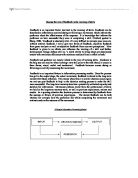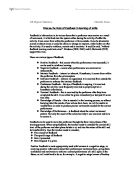As you can see form the table above all of these factors are affected by one another and how the coach uses feedback. So if a coach was to motivate his athlete then more likely this will encourage the player to improve and will make them better at their skill and they will have no faults in technique. This will also help them to develop through the learning phases, so it almost a full circle of each helping the other to progress.
I have just used some of the types of feedback and now I will define of all them and give an example from either a team, individual and racquet activities.
Guided from http://www.brianmac.demon.co.uk/infofb.htm - accessed March 20, 2007
The types of feedback I have just defined vary on how their given, factors such as classification of skills, individual differences such as the phases of learning and open and closed loop control.
Guided from Honeybourne, Hill and Moors (2004)
Open loop control is when unconsciously we make decisions on what muscles need to be used during an activity. It has no feedback and it is usually a fast movement such as a baseball swing. If the environment remains constant and predictable then a motor programme can be used effectively. Below is a diagram of the open loop model.
Closed loop control involves the process of feedback and for this type of control it is internal and is involved in correction – detection process. Info comes from proprioception/kinesthesis and is used to detect and correct errors in performance. Sensory receptors send info directly to the muscle to correct the movement. For example balancing in gymnastics on a beam you move tour arms to keep upright which is intrinsic as you are doing it yourself. Below is the closed loop control.
Finally as already explained earlier the type of feedback also changes for the different type of learning phase the performer is at. If they are a cognitive learner then a lot of extrinsic feedback is needed for them to develop their skills as they don’t know right from wrong such as player has shot at goal and misses in football coach tells them to keep their down next time so it doesn’t go over. In the associative phase a mixture of feedback is needed so that they can develop their own intrinsic feedback and help develop themselves, and the extrinsic feedback would be in case they weren’t sure the other person would help guide them, like in basketball a person is learning to guard they have stopped the player going round them but they still shoot they will ask the coach if that was good. Finally the autonomous phase learner would sue intrinsic knowledge of performance and results and negative feedback. It is good to use these as the negative feedback motivates them as they know they should do better, and the knowledge of performance and results shows how well they did and they can interpret from this their own performance, using internal feelings, for example a defender sees his team has won 4-3 he knows the team has played good but not himself as he has conceded 3 goals.
Below is a table of the most common faults in different sports and the best feedback to use to rectify them.
Conclusion
It is essential that coaches give feedback to the performer or that the performer itself gets feedback that may be intrinsic or extrinsic as it is vital for improvement. If the coach is giving the feedback then he should use the most appropriate type of feedback for the learner. Things that can affect the type of feedback given and how appropriate it is, is the learner, the skill they are performing the phase of learning they are at and the coach expertise for example if it is a PE teacher helping a golf performer where the performer is better it would be best to use visual feedback as you can both discuss what is going on even though the PE teacher knows less. Also the feedback should be given terminally as quickly as possible after performance or you may forget what was wrong or correct, and it has to be clear so that the performer knows what to do next time, furthermore to have enough time before your next attempt to think over the feedback you’ve been given to utilise it properly. It is also important for the coach to develop the use of intrinsic feedback so that eventually it will ‘close’ the loop of control e.g. to develop autonomy.
Appendix 1
Phases of Learning
Cognitive – This is the first phase of learning, when performers are doing something for the first time and so need to understand what is being done. In this phase trial and error helps the performer to progress as they can use there past failures to help them avoid this mistake in the future. So they need to understand why they failed in order to rectify it. To make sure the new performer understands completely the teacher may need to show demonstrations or other guidance so that he performer can recognise what is most important to follow.
Associative (motor) – In this phase the performer practices and associates their movements with a mental image in their head produced from past experiences. This sis where feedback now starts to occur and you tell the performer where they are going wrong and the learner gradually becomes more aware of complex cues. This is also where you’d start to see a vast improvement in performance.
Autonomous – This is the final phase of skill-learning and movements are becoming automatic without any thought process. The performer will ignore the environment around them and concentrate on peripheral strategies and tactics. Reaction times are shorter as the motor skills are stored in the long-term memory. Most performers would not stay in this phase as they need to continuously refer back to the associative phase to reinforce motor skills.
Paraphrased form Honeybourne, Hill and Moors (2004)
Appendix 2
Thorndike’s ‘laws’
He developed a theory based on strengthening the S-R bond.
Law of exercise
Repeating or rehearsing the S-R connections is more likely to strengthen them. If the desired response occurs, reinforcement is necessary.
Law of Effect
If the response is followed by a satisfier, then the S-R bond is strengthened, but if it’s followed by an annoyer the bond is weakened. This means pleasant outcomes are likely to motivate the performer to do it again.
Law of readiness
The performer must be physically and mentally able to complete the task effectively.
Paraphrased form Honeybourne, Hill and Moors (2004)
Bibliography
American Psychological Association (APA): feedback. (n.d.). Dictionary.com Unabridged (v 1.1). from Dictionary.com website: Retrieved March 16, 2007,
Chicago Manual Style (CMS): feedback. Dictionary.com. Dictionary.com Unabridged (v 1.1). Random House, Inc. (accessed: March 16, 2007).
College of Human Sciences: information processing from http://pet4224c-01.sp00.fsu.edu/infoprocessing/sld005.htm - accessed March 20, 2007
Modern Language Association (MLA): "feedback." Dictionary.com Unabridged (v 1.1). Random House, Inc.. <Dictionary.com >. Accessed March 16, 2007
Sports Coach: information processing models from http://www.brianmac.demon.co.uk/infofb.htm - accessed March 20, 2007
– accessed on March 21, 2007
Word Count
1311







